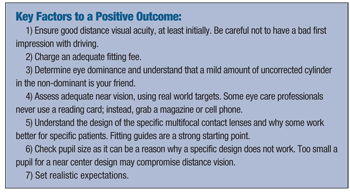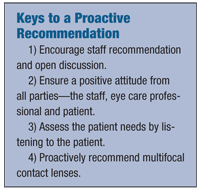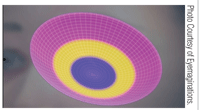 A new wave of presbyopic patients is here: the baby boomers and the Generation X’ers. The contact lens industry has taken note of this growing demographic trend and has developed new and innovative products—particularly in the soft disposable multifocal contact lens category. This month, we will discuss how to improve your success with presbyopic correcting contact lenses, thus providing your patients with visual freedom by minimizing their dependency on glasses.
A new wave of presbyopic patients is here: the baby boomers and the Generation X’ers. The contact lens industry has taken note of this growing demographic trend and has developed new and innovative products—particularly in the soft disposable multifocal contact lens category. This month, we will discuss how to improve your success with presbyopic correcting contact lenses, thus providing your patients with visual freedom by minimizing their dependency on glasses.
To start, here are three questions to consider when fitting multifocal contact lenses:
• Do you proactively recommend multifocal contact lenses or do you wait for the patient to inquire?
• What are the key factors that create a positive outcome with multifocal contact lenses?
• How many multifocal patients do you want to fit annually?
 The Proactive Approach
The Proactive Approach
• The Staff: In order to be successful with multifocal lenses, we need to have good communication skills—starting with your staff. Does your staff proactively discuss and recommend multifocal lenses? Do they help set the stage before you comes into the room?
Your staff is the primary route to success with multifocal lenses. You should start by seeing how they do: test them by telephone shopping your own office. Ask some key questions or give a possible scenario and see how they answer. Ask them if contact lenses are an option. Next, ask them about fees and gauge how they handle this difficult question, especially because multifocal contact lens evaluation and fittings typically are expensive.
If the responses are weak, you know to discuss this at your next office meeting. Another tip is to consider fitting any presbyopic staff members with multifocal lenses. They will then be able to speak from their own personal experience and will likely be excited to talk to patients about this new technology.
• The Doctor: How do we present multifocals as a visual correction option? Keep it simple; say that you recommend multifocal contact lenses for your patients with prescriptions similar to theirs. Describe it as a process where you will be personalizing the fit. We suggest using visual aids or props to help describe the design of the multifocal lenses. An image will allow you to better describe the ability to customize zones, which will provide the patient with optimal vision distance, intermediate and near.
Find the most effective way to set patient expectations. Start by understanding your patient’s visual needs and work to customize the lenses. Additionally, communicate the expected follow up visits and visual outcomes. Remember to under-promise and over-deliver. Let your patient know that these contact lenses can provide clear and comfortable vision for about 90% of their visual needs, but that they may need reading glasses or extra magnification for small print. If they don’t need a second pair of glasses, you will be their hero.
Finally, determine the most effective way to explain adaptation to multifocal contact lenses. Although typically we may not discuss this process with our patients, try introducing the topic in the beginning. Let your patient know that it will take a little while for their eyes to adapt to the new multifocal design, just like it would for any new pair of spectacles. In some cases, it may take up to four weeks for the patient’s eyes to get adapted to the simultaneous vision design of soft multifocal contacts. Once again, visual aids help describe the ability for our eyes to see at various distances at the same time.
 Thinking Positively
Thinking Positively
It is a good idea to narrow down your preferred method of fitting presbyopes with contact lenses and to pick a fallback method. Is it textbook multifocal, utilizing the fitting guide or modified monovision? The answer to this will likely depend on your patient’s visual expectations and demands. We recommend a multifocal lens in the non-dominant eye when working with emerging presbyopes. This allows the patient to retain much of the quality of distance vision while offering additional functionality with near tasks.
With advanced presbyopes, this may require some creativity. It is important to realize success is not defined as wearing multifocal lenses in each eye with no other form of vision correction. Every patient will have different visually acceptable endpoints, which may be difficult to determine at the beginning of the fitting process. By initially setting proper expectations and following the fitting guides for advanced presbyopes, we will determine the advantages and disadvantages experienced by the patient after having a chance to wear the lenses. Then, by following the manufacturers’ fitting guides, we have the ability to enhance either distance or near vision depending on the patient’s needs. After the fitting process, if someone prefers to go back to single vision lenses, we dispense a week-long trial supply of single vision lenses before finalizing a prescription. Often times patients may forget how burdensome it is to not have the ability to see clearly up close; after going through the single vision lens trial, they may request the multifocal lenses for the convenience of no longer needing reading glasses.
Why start with multifocal lenses? There are multiple studies which show that patients prefer multifocal lenses over monovision at a rate of about 3:1.1,2 From the practitioner’s perspective, the multifocal contact lenses advantages are innumerable—improved intermediate vision, flexibility with fitting process, improved binocular vision and the ability to differentiate your practice.
However, others have wondered if the amount of revenue in fitting presbyopic patients balances the practitioner’s time and patience to make the patient happy. On average, most eye care professionals need two to three follow-up visits to successfully fit multifocal contact lenses. Some of the newer multifocal lenses will help reduce the time spent in each follow-up appointment. Remember that it is not hard to figure out when to fit multifocal lenses, it is difficult to decide when to stop fitting multifocal lenses.
To help reduce the number of follow-up appointments, our suggestion is to spend some extra time on the dispensing visit. At these visits, allow the lenses to settle for 15 to 20 minutes and then assess the fit and vision. If you can make the minor adjustments to improve the vision (at distance and near), you will better streamline the fitting process. If ever there is a question, we recommend erring on the side of caution—give your patient more distance vision to start. Take the time to develop your protocol and include your staff in this process.

Visual aids and images can help better explain multifocal lenses.
Plan for the Future
Just like most things that we would like to improve upon, it is important to know where you are in order to figure out where you want to go. Start by analyzing your numbers: calculate the number of fits you have done in the past three months and set a goal for the next three months. There are always opportunities to take your multifocal contact lens fittings to the next level.
Practitioners who actively embrace these patients will solidify themselves as the contact lens expert in their respective communities. The specialized contact lens service will help you not only increase profitability, but will also increase your practice referrals.
1. Benjamin WJ. Comparing multifocals and monovision. CL Spectrum. 2007 Jul. Available at:
www.clspectrum.com/article.aspx?article=100637 (accessed July 2011).
2. Richdale K, Mitchell GL, Zadnik K. Comparison of multifocal and monovision soft contact lens corrections in patients with low- astigmatic presbyopia. Optom Vis Sci. 2006 May;83(5):266-73.


